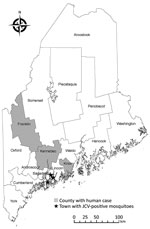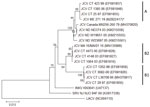Volume 28, Number 11—November 2022
Dispatch
Jamestown Canyon Virus in Collected Mosquitoes, Maine, United States, 2017–2019
Abstract
Jamestown Canyon virus (JCV) is a mosquito-borne arbovirus that circulates in North America. We detected JCV in 4 pools of mosquitoes collected from midcoastal Maine, USA, during 2017–2019. Phylogenetic analysis of a JCV sequence obtained from Aedes cantator mosquitoes clustered within clade A, which also circulates in Connecticut, USA.
Jamestown Canyon virus (JCV; family Peribunyaviridae, genus Orthobunyavirus) is a mosquitoborne virus that belongs to the California serogroup. Although rare, JCV infection in humans can cause acute febrile encephalitis, meningitis, and meningoencephalitis (1). JCV was identified from Culiseta inornata mosquitoes in Jamestown Canyon, Colorado, USA, in 1961 (2). Since then, JCV has been detected in humans in the United States and Canada (1).
JCV has been isolated from >26 species of mosquitoes belonging to Aedes/Ochlerotatus, Anopheles, Coquillettidia, Culex, Culiseta, and Psorophora genera (3,4). White-tailed deer (Odocoileus virginianus) are likely the primary amplifying host of JCV (5), but moose (Alces alces), elk (Cervus elaphus), and bison (Bison bison) also might contribute to the transmission cycle (6). In Maine, moose and white-tailed deer are distributed statewide (7).
In 2017, two confirmed symptomatic human JCV cases were reported in Maine, and a subsequent fatal case was reported in the state in 2018 (8). All 3 cases occurred in women >65 years of age who resided in 3 counties: Kennebec, Franklin, and Knox (Figure 1) (8). Because JCV was recently identified in Maine, mosquito testing could help delineate the geographic distribution of JCV in the state. We collected and tested mosquitoes for JCV to obtain viral genomic sequences, conduct phylogenetic comparison, and determine whether JCV from Maine was congruent with published JCV sequences from the northeastern United States.
We trapped mosquitoes during mid-June–September each year during 2017–2019 in 36 towns in 9 of Maine’s 16 counties, representing southern, midcoastal, and northern regions of the state. We used CDC Miniature Light Traps (John W. Hock Co., https://www.johnwhock.com) baited with CO2 by using dry ice. We deployed 1 trap per site once per week and set the traps to run overnight from ≈2:00 PM–10:00 AM Eastern Standard Time. We identified mosquitoes’ sex and species and pooled only female mosquitoes by species, collection site, and collection date, <50 mosquitoes per pool.
We extracted RNA from mosquito pools by using the QIAmp Viral RNA Mini Kit (QIAGEN, https://www.qiagen.com) following manufacturer protocol. We tested pools for JCV by reverse transcription PCR (RT-PCR) by using the SuperScript III One-Step RT-PCR System with Platinum Taq DNA polymerase (Invitrogen, https://ww.invitrogen.com) and primers designed to amplify 24 viruses within the Bunyamwera-California complex, including JCV (9).
We subsequently analyzed mosquito pools that tested positive for JCV RNA by using JCV-specific primers that target a 605-bp region of the nucleocapsid and nonstructural genes within the small segment (9). We conducted RT-PCR in the same manner described above but used Platinum Taq High Fidelity DNA Polymerase (Invitrogen). The University of Maine DNA Sequencing Facility (Orono, ME, USA) sequenced positive samples obtained from both primer sets. We confirmed JCV identities by BLASTn (https://blast.ncbi.nlm.nih.gov/Blast.cgi).
We compared 1 positive sequence against 18 previously published orthobunyaviruses obtained from GenBank. We performed phylogenetic analysis in MEGA X (https://www.megasoftware.net) by using the neighbor-joining method and maximum composite likelihood model. We calculated 1,000 bootstrap replicates to provide support for each node.
During 2017–2019, we collected 13,023 mosquitoes from 36 towns in 9 counties in Maine, a total of 162 trap nights. We tested a total of 689 mosquito pools representing 24 species for the presence of JCV RNA by RT-PCR. Among all pools, 4 (0.6%) pools representing 4 (16.6%) different species were positive for JCV viral RNA (Table 1).
We detected JCV RNA in each of the 3 years of the study: in 1 positive pool of Aedes provocans mosquitoes in 2017; 2 positive pools in 2018, 1 each of Ae. sollicitans and Uranotaenia sapphirina mosquitoes; and 1 positive pool of Ae. cantator mosquitoes in 2019. All sequences matched other JCV sequences in GenBank with >99% identity. All JCV-positive mosquito pools were collected during a 3-week period, June 30–July 19. Although the testing effort represented the southern, midcoastal, and northern parts of the state, the positive mosquito pools originated from 3 towns in 2 midcoastal counties, Arrowsic in Sagadahoc County and Edgecomb and Wiscasset in Lincoln County (Figure 1).
Because of a storage freezer failure, we were only able to resequence 1 of the original 4 JCV-positive pools with the second set of primers. We chose this sequence for phylogenetic analysis because it provided us with a larger portion of the genome and would be more robust for analysis. This JCV-positive pool was from Ae. cantator mosquitoes collected in the town of Edgecomb, Lincoln County, in July 2019. Phylogenetic analysis of the Edgecomb sequence (GenBank accession no. MZ822417) and 18 other sequences obtained from GenBank showed this JCV-positive sequence clustered within clade A described by a previous study (10), and had 99% nucleotide identity match with a JCV isolate from Connecticut collected in 2004 (GenBank accession no. HM007356) (Figure 2).
We detected JCV-positive mosquitoes in Maine, including 1 pool of Ur. sapphirina mosquitoes, a species not known as a JCV vector. In the southeastern United States, the Ur. sapphirina mosquito is considered a specialist of amphibians (11) and annelids (ringed worms or segmented worms), and 1 study from Florida found 100% of bloodmeals taken by Ur. sapphirina mosquitoes were from annelid hosts (12). However, in the northeastern United States, Ur. sapphirina mosquitoes appear to be generalists. In Connecticut, white-tailed deer have been identified as the most common vertebrate host for Ur. sapphirina mosquitoes, but additional bloodmeals from humans, birds, and reptiles are reported (13). The opportunistic feeding pattern of Ur. sapphirina mosquitoes in the northeast suggests this species might play a role in regional virus transmission.
In addition to Ur. sapphirina mosquitoes, we detected JCV RNA in Ae. cantator, Ae. provocans, and Ae. sollicitans mosquitoes, species known as mammalian pests that readily bite humans (14). The Ae. provocans mosquito is a known vector of JCV in New York, USA (15), and might serve as an overwintering reservoir (4). In Connecticut, Ae. cantator and Ae. sollicitans mosquito populations peak during late May through June and breed in saltmarshes and brackish water, which are common habitats along midcoastal Maine (14). Ae. canadensis mosquitoes have been identified as a dominant JCV vector in Connecticut (4). Although Ae. canadensis and Coquillettidia perturbans mosquitoes comprised most (44%) pools in our study, we did not detect JCV RNA in either species.
All JCV-positive mosquito pools in our study came from coastal counties, whereas the 3 human JCV cases during our study period came from 2 inland counties and 1 coastal county. Our sampling and testing effort was greater in the midcoastal region than in other regions of the state. A serosurvey for JCV antibodies in deer and moose in Maine might show a broader geographic extent than mosquito positivity and human cases (7).
In conclusion, the JVC sequence we obtained from Ae. cantator mosquitoes collected in 2019 from Edgecomb, in Lincoln County, Maine, clustered within clade A described by a previous study in Connecticut (10), where clade A is the most common clade, in addition to clades B1 and B2. Increased mosquito collection, testing effort, and phylogenetic analysis could elucidate the roles of particular mosquito species in JCV transmission, and better delineate the statewide phylogeographic distribution of JCV in Maine. Clarifying the distribution of JCV in mosquitoes in Maine can inform prevention efforts in the state.
Ms. Schneider is a research associate with the Vector-Borne Disease Laboratory at the MaineHealth Institute for Research. Her research interests include the environmental and ecological factors among disease vectors, hosts, and habitat.
Acknowledgments
We thank Sara Robinson and Haris Sohail for assistance with information on human case data. We also thank the many interns who helped with mosquito identification and the 2 anonymous peer reviewers whose helpful comments improved this dispatch.
The MaineHealth Institute for Research and the Maine Centers for Disease Control and Prevention provided funding for this project (Maine Department of Health and Human Services agreement no. CD0-19-7170B).
References
- Pastula DM, Hoang Johnson DK, White JL, Dupuis AP II, Fischer M, Staples JE. Jamestown Canyon virus disease in the United States—2000–2013. Am J Trop Med Hyg. 2015;93:384–9. DOIPubMedGoogle Scholar
- Sather GE, Hammon WM. Antigenic patterns within the California-encephalitis-virus group. Am J Trop Med Hyg. 1967;16:548–57. DOIPubMedGoogle Scholar
- DeFoliart GR, Anslow RO, Hanson RP, Morris CD, Papadopoulos O, Sather GE. Isolation of Jamestown Canyon serotype of California encephalitis virus from naturally infected Aedes mosquitoes and tabanids. Am J Trop Med Hyg. 1969;18:440–7. DOIPubMedGoogle Scholar
- Andreadis TG, Anderson JF, Armstrong PM, Main AJ. Isolations of Jamestown Canyon virus (Bunyaviridae: Orthobunyavirus) from field-collected mosquitoes (Diptera: Culicidae) in Connecticut, USA: a ten-year analysis, 1997-2006. Vector Borne Zoonotic Dis. 2008;8:175–88. DOIPubMedGoogle Scholar
- Boromisa RD, Grimstad PR. Seroconversion rates to Jamestown Canyon virus among six populations of white-tailed deer (Odocoileus virginianus) in Indiana. J Wildl Dis. 1987;23:23–33. DOIPubMedGoogle Scholar
- Grimstad PR. California group virus disease. In: Monath TP, editor. The arboviruses: epidemiology and ecology, vol. II. Boca Raton, FL: CRC Press; 1988. p. 99–136.
- Mutebi JP, Mathewson AA, Elias SP, Robinson S, Graham AC, Casey P, et al. Use of cervid serosurveys to monitor Eastern equine encephalitis virus activity in Northern New England, United States, 2009–2017. J Med Entomol. 2022;59:49–55. DOIPubMedGoogle Scholar
- Maine Centers for Disease Control and Prevention. Annual reports 2022 [cited 2022 Mar 16]. https://www.maine.gov/dhhs/mecdc/infectious-disease/epi/publications/index.shtml#annualreports
- Kuno G, Mitchell CJ, Chang GJ, Smith GC. Detecting bunyaviruses of the Bunyamwera and California serogroups by a PCR technique. J Clin Microbiol. 1996;34:1184–8. DOIPubMedGoogle Scholar
- Armstrong PM, Andreadis TG. Genetic relationships of Jamestown Canyon virus strains infecting mosquitoes collected in Connecticut. Am J Trop Med Hyg. 2007;77:1157–62. DOIPubMedGoogle Scholar
- Cupp EW, Zhang D, Yue X, Cupp MS, Guyer C, Sprenger TR, et al. Identification of reptilian and amphibian blood meals from mosquitoes in an eastern equine encephalomyelitis virus focus in central Alabama. Am J Trop Med Hyg. 2004;71:272–6. DOIPubMedGoogle Scholar
- Reeves LE, Holderman CJ, Blosser EM, Gillett-Kaufman JL, Kawahara AY, Kaufman PE, et al. Identification of Uranotaenia sapphirina as a specialist of annelids broadens known mosquito host use patterns. Commun Biol. 2018;1:92. DOIPubMedGoogle Scholar
- Molaei G, Andreadis TG, Armstrong PM, Diuk-Wasser M. Host-feeding patterns of potential mosquito vectors in Connecticut, U.S.A.: molecular analysis of bloodmeals from 23 species of Aedes, Anopheles, Culex, Coquillettidia, Psorophora, and Uranotaenia. J Med Entomol. 2008;45:1143–51. DOIPubMedGoogle Scholar
- Andreadis TG, Thomas MC, Shepard JJ. Identification guide to the mosquitoes of Connecticut. New Haven (CT): Connecticut Agricultural Experimental Station; 2005.
- Boromisa RD, Grayson MA. Incrimination of Aedes provocans as a vector of Jamestown Canyon virus in an enzootic focus of northeastern New York. J Am Mosq Control Assoc. 1990;6:504–9.PubMedGoogle Scholar
Figures
Table
Cite This ArticleOriginal Publication Date: October 14, 2022
Table of Contents – Volume 28, Number 11—November 2022
| EID Search Options |
|---|
|
|
|
|
|
|


Please use the form below to submit correspondence to the authors or contact them at the following address:
Elizabeth Schneider, MaineHealth Institute for Research, Vector-borne Disease Research Laboratory, 81 Research Dr, Scarborough, Maine 04074, USA
Top